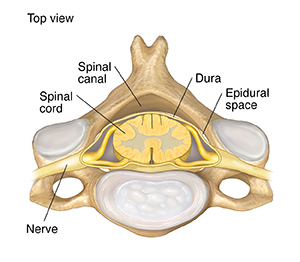A
B
C
D
E
F
G
H
I
J
K
L
M
N
O
P
Q
R
S
T
U
V
W
X
Y
Z
Click a letter to see a list of conditions beginning with that letter.
Click 'Topic Index' to return to the index for the current topic.
Click 'Library Index' to return to the listing of all topics.
Cervical Epidural Injection
For certain types of neck pain, your health care provider may suggest a cervical epidural injection. During this procedure, medicine (such as numbing medicine and a steroid) is injected deep into your neck near your spine. The injection helps the provider find the source of your pain. It can also help ease your pain and soreness for a short time or a long time. Ask your provider about the risks and benefits of the procedure.
The cervical vertebrae
The cervical vertebrae are the bones that support your neck and head. They form the top part of your spine. The tunnel made by these vertebrae is called the spinal canal. The spinal cord runs through the spinal canal and inside a sac called the dura. Nerves branch off the spinal cord and exit between the vertebrae. Pressure on one of these nerves may cause it to become inflamed. An inflamed nerve in your neck may cause pain, numbness, tingling, or weakness that you may feel in your neck, head, or arms.

The cervical epidural injection
In certain conditions, medicine can be injected into the epidural space. This space surrounds the dura within the spinal canal. An anesthetic (numbing medicine) is used to reduce discomfort from the procedure. Then a needle is inserted between the bones of the neck. When the correct location is reached, the medicine may be injected. The injection is usually done with the help of imaging, such as fluoroscopy. This helps guide the needle to exactly the right position. Care is taken to reduce the chance of infection from the procedure. Infection is rare, but can be serious. The procedure will be done by a health care specialist, such as a neurosurgeon, a pain specialist, an interventional radiologist, or an anesthesiologist.
Possible risks and complications
Serious complications of various types have been reported. Talk with your health care provider about the possible side effects and when they should be reported.
Online Medical Reviewer:
Marianne Fraser MSN RN
Online Medical Reviewer:
Michelle Johnson BSN RN AMB-BC
Online Medical Reviewer:
Rita Sather RN
Date Last Reviewed:
3/1/2025
© 2000-2025 The StayWell Company, LLC. All rights reserved. This information is not intended as a substitute for professional medical care. Always follow your healthcare professional's instructions.